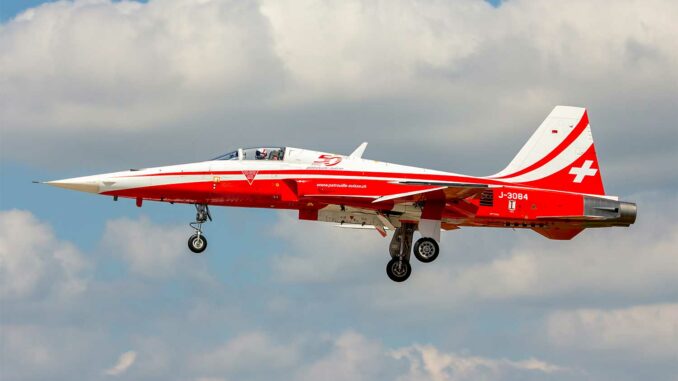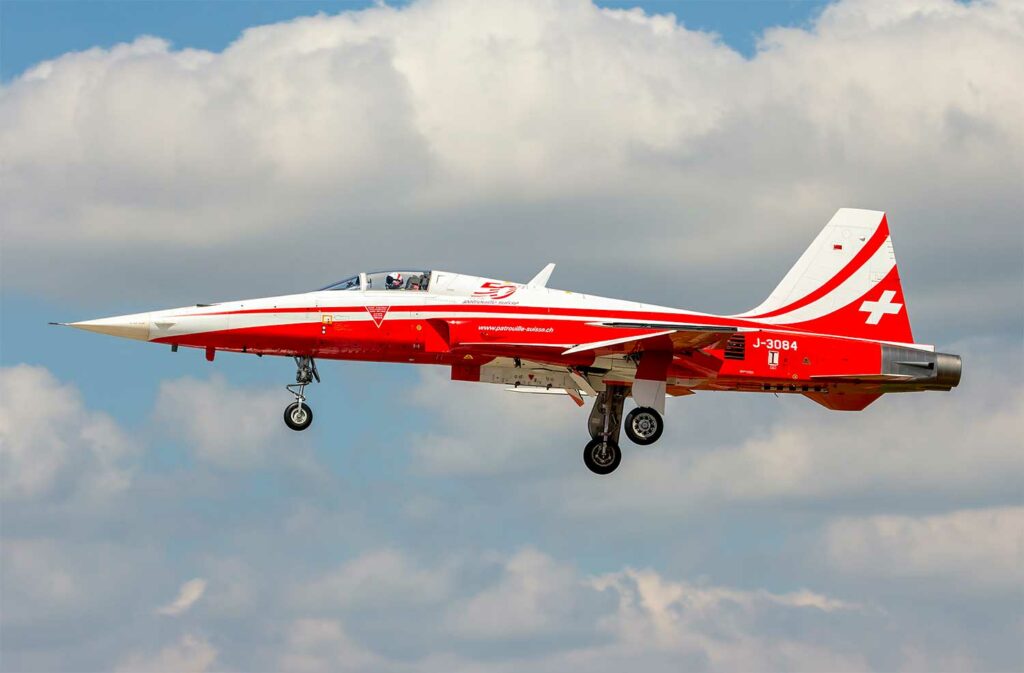
Switzerland is transferring 22 decommissioned F-5E/F Tiger IIs to the US Marine Corps for €30 million, freeing up space for F-35As. Technical and strategic details.
The Swiss authorities, via the Federal Office for Armament (armasuisse), have begun delivery of 22 decommissioned F-5E/F Tiger II fighters to the United States Marine Corps (USMC). The transfer, which was finalized in 2020 for approximately €30 million (US$32.4 million), includes 16 single-seat F-5Es and six two-seat F-5Fs, as well as ground equipment, spare parts, and logistical support. These aircraft, acquired by Switzerland in the 1970s and 1980s, are intended to enhance the training capabilities of US forces as opponent (OPFOR) aircraft to simulate air threats. This transaction is part of Switzerland’s strategy to modernize its fleet with the gradual introduction of Lockheed Martin F-35A aircraft by 2028, replacing both the F-5 and F/A-18C/D Hornet. The operation allows Switzerland to streamline its resources while offering the United States a cost-effective solution for its training needs.
Technical characteristics of the F-5E/F Tiger II
The Northrop F-5E/F Tiger II, designed in the 1960s, is a light supersonic fighter aircraft valued for its maneuverability, low operating costs, and reliability. Powered by two General Electric J85-GE-21C turbojet engines, each with 22.2 kN of thrust and afterburners, it has a maximum speed of Mach 1.63 (approximately 2,000 km/h at high altitude). It is 14.4 m long for the single-seat F-5E and 15.7 m for the two-seat F-5F, with a wingspan of 8.1 m. The maximum takeoff weight is 11,192 kg, with a payload including two M39A2 20 mm cannons, air-to-air missiles such as the AIM-9 Sidewinder, and bombs for ground attack. The Swiss F-5s, acquired as part of the Peace Alps and Peace Alps II programs, incorporate specific improvements: LN-33 inertial navigation systems, AN/ALQ-87 radar warning receivers, AN/ALE-40 countermeasure systems and Emerson AN/APG-69 radars for improved detection.
Approximately 2,700 F-5s were produced, including 792 F-5Es and 140 F-5Fs, with production licensed in Switzerland by the Federal Aircraft Factory (now RUAG Aerospace). Although outdated for modern combat, these aircraft excel in secondary roles thanks to their agility and operating cost, estimated at around $4,000 per flight hour, compared to more than $20,000 for an F-35. Their robustness allows for an extended structural life, particularly suited to intensive training missions.
The role of the F-5 in US Marine Corps training
The 22 F-5E/Fs acquired by the USMC will join adversary training squadrons such as VMFT-401 Snipers at Yuma Air Station, Arizona, and potentially VMFT-402, recently established at Beaufort Air Station, South Carolina. These aircraft simulate enemy tactics in air combat scenarios, providing realistic training for F/A-18 Hornet and F-35 pilots. The F-5N/F, a modernized version of the Swiss F-5E/F, is equipped with advanced avionics, including digital cockpits and modern threat simulation systems developed under the ARTEMIS (Avionics Reconfiguration and Tactical/Modernization for Inventory Standardization) program. This program, led by Tactical Air Support, Inc. in Cecil Field, Florida, includes inspections, repairs, and upgrades, with initial delivery scheduled for 2025 and completion in 2028.
Currently, the USMC operates 11 F-5Ns and 1 F-5F, while the US Navy has 30 F-5Ns and 2 F-5Fs in squadrons such as VFC-13 in Fallon, Nevada, and VFC-111 in Key West, Florida. The new F-5s will reduce pressure on existing fleets, which are often limited by wear and tear. The unit cost of approximately €1.4 million per aircraft, combined with affordable maintenance, makes it an economical solution compared to alternatives such as the F-16 or F/A-18 for training. This transfer strengthens the US military’s ability to simulate adversaries such as the MiG-21 and other light fighters, which are essential for preparing pilots for diverse combat environments.

Switzerland’s strategy for modernizing its air fleet
The delivery of 22 F-5s is part of a strategic transition by the Swiss Air Force to modern platforms. Switzerland acquired 98 F-5Es and 12 F-5Fs between 1976 and 1985, but only 25 F-5s remain in service, including 18 operational aircraft, mainly used by the Patrouille Suisse and for secondary tasks such as target towing and testing. With the arrival of 36 Lockheed Martin F-35As from 2028, approved in 2021 for approximately $5.5 billion, Switzerland is streamlining its resources. The F-5s, although reliable, are expensive to maintain due to their age, with estimates of 9 million Swiss francs (8.5 million euros) to keep 12 aircraft operational until 2027.
This sale, combined with the sale of 44 F-5s to the US Navy in 2008, frees up human, financial, and logistical resources for the F/A-18C/D Hornet and future F-35As. The choice of the F-35 sparked political debate, with movements such as Stop F-35 calling for a referendum, but the decision reflects the need for advanced capabilities in the face of modern threats, particularly Russian anti-aircraft systems such as the S-400. The remaining F-5s, used by the Patrouille Suisse, are expected to be retired by 2027, marking the end of their service in Switzerland.
The economic and operational implications of the transfer
The transfer of 22 F-5E/F aircraft for €30 million represents a financially advantageous move for Switzerland, avoiding storage or dismantling costs estimated at several million euros. For the United States, the acquisition is strategic: the F-5s, with an estimated remaining structural life of 10-15 years after overhaul, offer an economical alternative for training. The ARTEMIS program, involving RUAG for initial maintenance and Tactical Air Support for upgrades, ensures smooth integration. The work includes replacing structural components, overhauling the J85 engines, and installing modern cockpits, increasing the operational lifespan.
This transfer illustrates effective transatlantic collaboration, strengthening ties between Switzerland and the United States. However, it raises questions about growing dependence on expensive platforms such as the F-35, whose cost per flight hour could reach $30,000. Switzerland will have to balance its defense ambitions with budget constraints, while the USMC benefits from a strengthened training fleet at a lower cost. This model could inspire other nations with aging fleets to transfer their aircraft to partners for secondary roles.
War Wings Daily is an independant magazine.